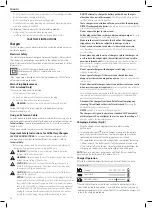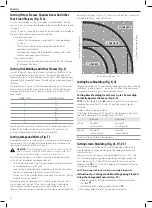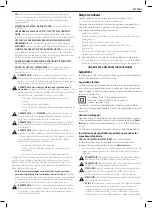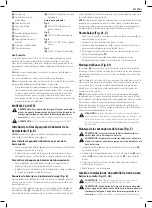
48
EnGLIsh
Changing or Installing a New Saw Blade
Removing the Blade (Fig. H1–H4)
WARNING:
To reduce the risk of injury, wear gloves when handling
the saw blade.
WARNING: To reduce the risk of serious personal injury, turn
tool off and disconnect battery pack before making any
adjustments or removing/installing attachments or accessories.
An accidental start-up can cause injury.
• Never depress the spindle lock button while the blade is under
power or coasting.
• Do not cut light alloy and ferrous metal (containing iron or steel)
or masonry or fibre cement product with this mitre saw.
1. Remove the battery from the saw.
2. Raise the arm to the upper position and raise the lower guard
1
as far
as possible.
3. Depress the spindle lock button
44
while carefully rotating the saw
blade by hand until the lock engages.
4. Keeping the button depressed, use the other hand and the 6 mm
wrench provided
31
to loosen the blade screw
43
. (Turn clockwise,
left-hand threads.)
5. Remove the blade screw
43
, outer clamp washer
45
and blade
46
.
The inner washer
48
may be left on the spindle.
6. Remove and retain the adaptor ring
47
from the old blade in case it is
needed when installing a new blade.
Installing a Blade (Fig. H1–H4)
1. Remove the battery from the saw.
2. Snap the ring adaptor ring
47
into the hole of the new saw blade
if necessary.
3. With the arm raised and the lower guard
1
held open, mount the blade
onto the shoulder of the inner washer
48
, making sure the teeth at the
bottom of the blade point toward the back of the saw.
4. Assemble the outer clamp washer onto the spindle.
5. Install the blade screw and, engaging the spindle lock, tighten the
screw firmly with wrench provided (turn counterclockwise, left-
hand threads).
WARNING!
Be aware the saw blade shall be replaced in the described
way only. Only use saw blades as specified under
Technical Data
;
Cat. no.: DT4260 is suggested.
Transporting the Saw (Fig. A1, A2)
WARNING: To reduce the risk of serious personal injury,
ALWAYS
lock the rail lock knob, mitre lock handle, bevel lock handle,
lock down pin and fence adjustment knobs before transporting saw.
Never use guards for transporting or lifting up.
In order to conveniently carry the mitre saw, a carrying handle
3
has been
included on the top of the saw arm.
• To transport the saw, lower the head and depress the lock down
pin
11
.
• Lock the rail lock knob with the saw head in the front position, lock the
mitre arm in the full left mitre angle, slide the fence
13
completely
inward and lock the bevel lock knob
33
with the saw head in the
vertical position to make the tool as compact as possible.
• Always use the carrying handle
3
or the base extensions
15
.
Features and Controls
WARNING: To reduce the risk of serious personal injury, turn
tool off and disconnect battery pack before making any
adjustments or removing/installing attachments or accessories.
An accidental start-up can cause injury..
Mitre Control (Fig. A2, I)
The mitre lock handle
21
and mitre latch button
22
allow you to mitre
your saw to 60° right and 50° left. To mitre the saw, lift the mitre lock
handle, push the mitre latch button and set the mitre angle desired on the
mitre scale
19
. Push down on the mitre lock handle to lock the mitre angle.
Override the mitre latch button by unlocking the mitre lock knob and
pushing the mitre detent override
38
downward. To exit the override, push
the mitre detent override upward.
Bevel Lock Knob (Fig. A2)
The bevel lock allows you to bevel the saw 49° left or right. To adjust the
bevel setting, turn the bevel lock knob
33
counterclockwise. The saw head
bevels easily to the left or to the right once the 0° bevel override knob is
pulled. To tighten, turn the bevel lock knob clockwise.
0° Bevel Override (Fig. A2)
The 0° bevel stop
34
override allows you to bevel the saw to the right past
the 0° mark.
When engaged, the saw will automatically stop at 0° when brought up
from the left. To temporarily move past 0° to the right, pull the bevel lock
knob
33
. Once the knob is released, the override will be reengaged. The
bevel lock knob can be locked out by twisting the knob 180°.
When at 0°, the override locks in place. To operate the override, bevel the
saw slightly to the left.
45° Bevel Stop Override (Fig. J)
There are two bevel stop override levers, one on each side of the saw.
To bevel the saw, left or right, past 45°, push the 45° bevel override
lever
55
rearward. When in the rearward position, the saw can bevel past
these stops. When the 45° stops are needed, pull the 45° bevel override
lever forward.
Crown Bevel Pawls (Fig. J)
When cutting crown molding laying flat, your saw is equipped to accurately
and rapidly set a crown stop, left or right (refer to
Instructions for Cutting
Crown Molding Laying Flat and Using the Compound Features
)
The crown bevel pawl
57
can be rotated to contact the crown
adjustment screw.
To reverse the crown bevel pawl, remove the retaining screw, the 22.5°
bevel pawl
56
and the 30° crown bevel pawl
57
. Flip the crown bevel
pawl
57
so the 30° text is facing up. Reattach the screw to secure the
22.5° bevel pawl and the crown bevel pawl. The accuracy setting will not
be affected.
22.5° Bevel Pawls (Fig. J)
Your saw is equipped to rapidly and accurately set a 22.5° bevel, left or right.
The 22.5° bevel pawl
56
can be rotated to contact the crown adjustment
screw
54
.
Rail Lock Knob (Fig. A1)
The rail lock knob
6
allows you to lock the saw head firmly to keep it from
sliding on the rails
9
. This is necessary when making certain cuts or when
transporting the saw.
Grooving Stop (Fig. A2)
The grooving stop
30
allows the depth of cut of the blade to be limited.
The stop is useful for applications such as grooving and tall vertical cuts.
Rotate the grooving stop forward and adjust the depth adjustment
screw
29
to set the desired depth of cut. To secure the adjustment, tighten
the wing nut
28
. Rotating the grooving stop to the rear of the saw will
bypass the grooving stop feature. If the depth adjustment screw is too tight
to loosen by hand, the provided 6 mm blade wrench
31
can be used to
loosen the screw.
Lock Down Pin (Fig. A1)
WARNING:
The lock down pin should be used only when
carrying or storing the saw. NEVER use the lock down pin for any
cutting operation.
Содержание DCS727
Страница 1: ...Final Page Size 172 x 240 mm DCS727 ...
Страница 4: ...2 Fig D Fig C Fig B Fig E Fig F 41 42 5 4 61 4 5 39 68 40 36 ...
Страница 5: ...3 Fig G Fig H4 Fig I Fig H1 Fig H2 Fig H3 1 44 1 43 31 21 22 19 51 49 50 46 43 45 31 48 47 ...
Страница 6: ...4 Fig N Fig O1 Fig L Fig M Fig K 21 21 60 62 Fig J 10 59 52 53 54 55 56 57 58 ...
Страница 7: ...5 Fig O2 Fig Q Fig S Fig P Fig T Fig R 2 1 A 1 2 ...
Страница 8: ...6 Fig X1 Fig W1 Fig W1 Fig V2 Fig V1 13 46 17 13 46 13 13 17 Fig U ...
Страница 9: ...7 Fig X2 Fig Y Fig AA Fig Z 1 63 64 15 16 66 65 67 ...
















































